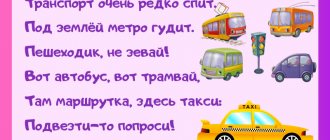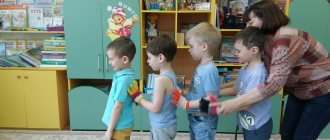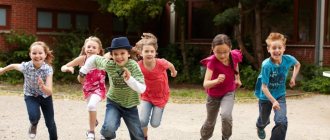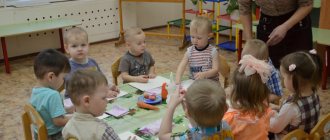The methodology for identifying the creative abilities of younger schoolchildren is based on educational activities. It not only reveals the knowledge and skills necessary for life in society. The main goal of the methodology is the development of personality and its self-realization, the creation of one’s own ideas and their implementation.
Creativity is understood as changing reality with the help of extraordinary, new, unique ideas. When assessing the level of such abilities, one should take into account the different degrees of development of children. A big role is played by: perception, imagination, resourcefulness, originality.
Diagnostics to identify creative abilities in primary schoolchildren
It is necessary to diagnose creative and mental abilities from an early age.
This reveals the child's development indicators. The range of abilities depends on physical health, perception of the surrounding world, upbringing and psycho-emotional state:
- minimal manifestation (lag);
- age-appropriate level (normal development);
- manifestation of a high level (anticipation).
The main goal of diagnostics is the timely identification of lagging and gifted children. This allows us to develop further activities aimed at the further development of schoolchildren.
Common diagnostic methods include testing:
- graphic;
- oral;
- situational.
To achieve the most effective result, the techniques are combined.
Methods and techniques of study
The use of effective methods for studying creative abilities is structured as follows.
- Primary diagnosis.
A written survey of parents and children is conducted. Supervision of children at school and at home is organized.
- Carrying out special diagnostics.
At the second stage, tests are carried out, questionnaires are filled out, and creative tasks are completed.
To determine a child’s ability to be creative, adults are asked to answer a list of questions: parents and teachers. For this, it is good to use the “Giftedness Map”. This test was developed according to the method of Haan and Cuff. The questionnaire can include up to 80 questions. Time to answer: 15 minutes. After processing the results, the degree of giftedness of the child is revealed. A convenient systematization of the results shows what type of abilities the child is currently developing. The ten scores obtained constitute an “individual portrait” of abilities. Based on the results obtained, a personal development program can be drawn up.
The second most popular method is the “Palette of Interests” survey. The questions in the questionnaires are designed to reflect the child’s interests in several areas:
- mathematics and technical direction;
- humanitarian field;
- activities in the field of art;
- development;
- sports direction;
- communication;
- natural science;
- household duties.
Using the technique, you can study the presence/absence of certain abilities in a child. Then carry out more accurate diagnostics in more or less developed areas.
Diagnosing parental abilities
To identify the child’s expected level of creativity, his parents are tested. To do this, use a special questionnaire “Degree of development of creativity.”
It contains statements about attitudes towards various processes. Using the “+”/“-” signs, participants indicate their agreement (disagreement) next to the item.
- I don't like working with a clearly developed algorithm.
- I like abstract painting, I understand it.
- I don't like doing work that is regulated by instructions.
- I don't like visiting museums. Everything about them is boring and monotonous.
- I love to fantasize.
- Hobbies add additional interest to a person's life.
- I can happily watch the same performance several times. The actors give different performances and new interpretations make it fun to watch.
- In my opinion, it is better to be a cutter. It's easier than being a tailor.
- I like the process of work. I have little interest in what the result will be.
- Any business requires a creative approach.
- I often doubt what others recognize as correct.
- I don't want to build my life according to certain rules.
- I like the work of artists.
- I like to go different ways.
Development of creative thinking
You can enroll your child in a productive center for the development of children’s creativity, where specialist teachers will help develop the child’s creative thinking and imagination, but it is much more important to pay attention to the development of the child in the family.
Despite having a diploma, a teacher will not be able to achieve the desired result without the participation of parents.
Development of creative abilities of children in the family
Note! The main condition for the development of creative abilities in a child in the family is the parental example. If a parent believes and voices that all this is nonsense, a waste of time and it is better to do something serious and useful, then the child is unlikely to be happy to take up markers or start sculpting from plasticine.
You need to find something you like and devote at least a small amount of free time to it. In this case, even if the baby does not show any interest in creativity, sooner or later he will begin to wonder what his father, mother, older or younger brother is doing so enthusiastically, and then he himself will begin to get involved in the process.
Collaborative creativity develops better
Methods for developing the creative abilities of preschoolers
The methodology is a system of tools and teacher actions aimed at developing the child’s creative abilities.
Games for developing memory and attention in children
For your information! The main method for children of this age will, of course, be play. Its relevance will never go away. It is through play that children easily learn new knowledge and gain skills. For them, this technique is the most effective, exciting and productive.
There is also a group of techniques:
- verbal;
- practical;
- visual.
Development of associativity in the game
Exercises for children aimed at forming associations (the relationship between objects, events) have a positive effect on mental development, developing thinking and imagination.
Games according to the Federal State Educational Standard for the development of associativity are very simple, for example, you can select the object “dog” and, together with your child, name or write words that can be associated with the dog (collar, muzzle, leash, bone, tail, booth, barking, etc. ). Or select cards so that each has a pair, then mix them and give the child the opportunity to reunite the pairs (umbrella - rain, night - sleep, toothbrush - toothpaste, musical instrument - note, presentation - projector, drawing - brush, meeting – parents, instrument technician and others).
Development of systems thinking
Systemic thinking is what will free the child from memorizing a large amount of information, which most of the time is unclaimed. Developed systems thinking allows you to relate objects to each other, see the world as a set of parts that have relationships with each other, highlight these parts, allow you to generalize, draw conclusions and conclusions based on available facts. Special exercises help develop systems thinking.
For your information! It is important to teach a child to play in such a way that he can come up with many interesting things with one object. It is best to purchase multi-tasking toys with which you can create several games, for example, cups that stack on top of each other. They can be used by nesting them, stacking them on top of each other like a pyramid, playing with them in the sand, in the water, learning colors, counting, the concept of size, more, less, average and much more.
Parents must lead by example
Dialecticality of preschoolers
Dialecticality is a very interesting property, which consists in the fact that a person can detect inconsistencies, contradictions, and features. It is an integral part of critical thinking. It is effective to develop dialecticism with the help of the game “Pros and Cons”. The essence of this game is that the child is asked to highlight the positive and negative aspects of a character or event.
It is not so important if the child is not always able to achieve a certain result after creative activities. He will receive the main benefit in the process of creative activity.
Methods for developing and diagnosing the creative abilities of younger schoolchildren
The most common method for identifying abilities is the “Completing Figures” test (authors: O.M. Dyachenko, A.I. Kirilova).
Diagnostics allows you to evaluate the productivity and originality of the approach to implementation. Children are given cards with figures on them. The difficulty of the test is determined by the age and development of the child. For example, a card may only show circles. By completing each circle, children, in their own minds, bring them to the highest degree of resemblance to various objects. Several figures can also be depicted on the card, forming some kind of blank for a drawing that needs to be completed according to your imagination.
Possible diagnostic results:
- "Zero" type.
The student does not finish drawing the figure. Perhaps he will depict some of his drawings next to the figure. Reason: incorrect perception of the task, ignoring the request, manifestation of one’s own imagination.
- "First" type.
The student refines the figure so that it becomes one of the elements of the image. The result is a schematic image of an object without small and detailed details.
- "Second" type.
The figure is drawn with small details and details so that a complex image is obtained.
The second most popular test for identifying abilities is the method developed by E.A. Panko "Invent a game." Goal: come up with a new game, its name, determine the number of participants, rules of the game, equipment, etc. At the same time, the child’s ability to predict, organize activities, and quickly solve problems is determined.
The student is given a task - to come up with a game, which must be completed within 5 minutes. Then the child is asked questions that he must answer.
- What is the name of the game?
- What is she? Why do they play it?
- How many players are required?
- What are the roles of the participants?
- What place do you choose to play?
- What are the rules?
- How (what?) should the game end?
- What bonuses (penalty points) do players receive?
When answering, teachers’ attention is drawn not to the speech, but to the completeness and content of the invented game. If there are difficulties, it is recommended to ask the student leading questions, but avoid giving hints.
Using a situational technique
The “Verbal Fantasy” technique developed by R.S. Nemov is also well suited for identifying creative abilities.
In 1 minute, a schoolchild must come up with a story/story/fairy tale about some animate character: an animal, a fictional creature, or an inanimate object, at the child’s discretion. The invented story must be told within 5 minutes.
The student’s creativity is assessed based on the following criteria:
- Speed of plot creation;
- Originality of content;
- The degree of use of real and unreal characters;
- Characteristics of images.
Development of creative abilities in preschool children: creativity
Creativity is a quality that will be useful to a child in adulthood, so its development needs to be given enough attention.
Experts offer several ways to develop creativity:
- Give your child free time. Constantly play with the baby and entertain him. Inventing games for him will not be beneficial for the development of his imagination.
- Refuse a large number of modern toys. These things do not allow the baby to fantasize. When the toy is simple, the child is forced to invent some elements or an unconventional way of using it.
- Less control. It is necessary to give the child room for imagination. Let him do what he likes without constant supervision.
- Develop talents. The family should help the child find something he likes. By visiting various clubs and looking for hobbies, you can interest your little one.
- Creative atmosphere. It is important for a child that he has his own children's room or creative corner, an area in which he is free to do whatever he wants. Let him assemble models from the construction set there, play outdoor games, the main thing is not to interfere with his creative impulses.
- Unbridled fantasy. It is useful to fantasize and make up different stories with your baby. You can watch a cartoon with him or read a fairy tale, and then fantasize about what he would do in the place of this or that hero. A theatrical family evening develops imagination well.
- Lead by example. It is useless to teach a child something if he does not see an example in the family. Parents need to engage in some kind of creativity themselves and create in the presence of the baby, raising their level.
Creativity is given special attention
The meaning and types of creative activity
The main significance of creative activity is that it contributes to the development of the baby’s speech.
Mathematics classes with children 6-7 years old in preschool educational institutions and at home
Note! This is due to the fact that creativity stimulates the development of fine motor skills of the hands (the ability to make small and precise movements), and motor skills directly affect the speech center in the brain.
The main types of creativity are:
- artistic;
- scientific;
- technical
Some authors also highlight sports creativity, the purpose of which is to fulfill standards.
The purpose of artistic creativity is to create a work of art (song, painting, poem, etc.).
The goal of scientific creativity is to obtain new knowledge through discoveries, experiments, and research.
The goal of technical creativity is to create mechanisms.
Motor skills must develop
How to create conditions for the pedagogical process of developing creativity
The task of a teacher is to constantly develop and improve. While developing the creativity and imagination of his students, he should not forget about himself. The following will help create conditions for the pedagogical process of developing creativity:
- Constant self-development and “soul-searching”, evaluating oneself as an individual and a professional. It is worth improving visual, artistic, song taste.
- Creative activities with children.
- Attending open classes of other teachers, forums, seminars. It is important to update didactic material; you can write a course project, a research paper, improve your activities, and draw up a work plan.
Keys to Developing Creativity
In order to purposefully develop creativity and grow creatively, the basic concepts are defined: the “keys” to launching. They are understood as factors that contribute to the emergence, development and further use of a child’s own potential.
- Knowledge.
- The ability to control the situation.
- Experience.
It is necessary to accumulate positive experiences of children who have learned to use creative thinking. It is important to share this experience with other students.
- Support for leaders.
Singling out children with pronounced abilities so as not to “over-praise” or belittle the efforts of others. Raising in successful children a willingness to share and experience in achieving success.
- Awards and promotions.
- The power of emotions.
Keeping your child in a good mood even when an attempt fails encourages “belief next time.”
- Broad outlook.
Reading, interviews, and discussion of what you read develop the ability to be creative.
- Independence, lack of an “anchor”.
Children who can easily switch from idea to idea find it easier to be flexible.
- Ability to play.
- Persistence.
- The ability to empathize.
Children who can hear others have the gift of “group” creativity. They are able to perceive the unrealized ideas of other children, add something of their own to them and present them as a joint solution.
- Developing self-respect.
- Inventiveness, open-mindedness.
- The ability to go beyond.
Creating combinations of ideas and solutions, combining ideas into groups according to direction stimulates the development of creativity.
- Introspection.
Summing up the results of a test, game or survey should encourage the child to develop further, and not “get hung up” on an unsuccessful result.
- Balance between feelings and thinking.
- Courage, self-confidence.
- Ability to take risks.
It is necessary to explain to the child that not all, even the most daring creative decisions are doomed to success. The willingness to take risks and fail should encourage further improvement of the idea.
- Understanding and prioritizing creativity.
Thinking creatively more often than is usually possible is the motto of every day.
- Responsibility.
This is a potential that will not allow you to pass off other people’s ideas as your own. At the same time, responsibility must be different from routine. It should not interfere with the implementation of creative ideas.
- Discipline.
Memo for parents, or practical advice
Children may show an inclination towards several areas of activity at once. Or inclinations may not be very clearly expressed. If you have been watching your child for a long time, but are not entirely sure what abilities need to be developed, a simple test will help you determine the correct answer.
Read the following statements carefully and confirm or refute them:
- Excellent memory for poems and stories.
- The child senses your mood.
- The child asks educational questions, for example, who invented time.
- Excellent terrain orientation (even in an unfamiliar area).
- A ballerina would envy the baby’s gait.
- My favorite thing to do is listen to music.
- The circle of interests is the surrounding world: thunderstorms, lightning, rain, snow, etc.
- Perfect auditory memory: if you rearrange the words in your favorite book, he will definitely correct you.
- He quickly mastered tying shoelaces or riding a bicycle.
- You regularly become a spectator of a home theater with your favorite child in the leading role or a participant in creative evenings.
- During the trip, the child's attention is focused on the features of the area.
- Perfectly distinguishes the sound of musical instruments.
- It is much easier for a child to schematically depict an area than to explain it in words.
- Accompanying most words and movements with active facial expressions.
- All toys are in place from smallest to largest or sorted into cabinets according to color or size.
- He explains his actions by the feelings he experienced at that moment.
- Every day you listen to amazing stories that “happened” to your baby.
- Every sound heard is given a comment.
- In all strangers he looks for similarities with children or adults he knows.
- Surprises you with a clear assessment of your strengths and capabilities (for example, I can’t carry this bag, it’s too heavy).
Key to understanding
- If you confirmed statements 1, 8, 17, the child exhibits linguistic abilities.
- If you confirmed statements 6, 12, 18, the child’s musical abilities are evident.
- If you confirmed statements 3, 7, 15, your baby has mathematical abilities.
- If you confirmed statements 5, 9, 14, your baby has sensory abilities.
- If you confirmed statements 10, 16, 20, your baby has a tendency towards self-knowledge.
- If you confirmed statements 2, 10, 19, the basis for development is psychological abilities.
- If you confirmed statements 4, 11, 13, topographical (spatial) abilities are clearly expressed.
Now you are fully armed, because you know exactly what abilities a child needs to develop so that in the future he will reach incredible heights. Your child's success is in your hands. The main thing is not to give in to temptation and not to instill in your child qualities he does not need. By developing your natural inclinations, you will achieve maximum success in its development.
Diagnostics: scientific approaches, principles and criteria
It is impossible to diagnose creativity without studying and applying the science on which the methods, principles and criteria are based.
Scientific approaches to research
In the process of studying the disposition to creativity, two approaches are distinguished.
- The study of creativity as a process of creative cognitive activity. It is based on the interaction of intelligence, speculative abilities, and their manifestation in practice.
The following people worked on the approach: D. Guilford, S. Mednik, A. Ponomarev, E. Torrence, S. Taylor. The principles are based on research that shows how intelligence influences the process of creating original new ideas. Different people can be observed.
- A study of the creative personality itself.
Here we are talking about the complex of creative abilities of one person. The approach is based on creating a “portrait” of a creative personality. This direction was developed by: A. Maslow, D. Bogoyavlenskaya, F. Barron.
Principles of the methodology for diagnosing creative abilities
When choosing methods for studying creative abilities, it is necessary to take into account the child’s age and testing conditions.
Diagnostic techniques are aimed at identifying stereotypical thinking. The main indicator of creativity is distance from cliches, a complete rejection of stereotypes.
Uniqueness is determined by the frequency of unusual responses. Uniqueness is assessed by the ratio of the number of new ideas and the total number of responses.
The result of a study may not always reflect the degree of a person’s ability to think creatively. Creativity can manifest itself spontaneously in every person and be unregulated.
The imperfection of all developed test methods is based on a general approach. They do not take into account the “surprise effect” of the manifestation of individual characteristics in a specific situation.
Criteria for evaluation
Indicators by which the level is determined:
- speed and ease of creativity (the number of proposed options during the task is counted);
- “flexibility” of answers (ability to switch);
- originality (frequency of repetitions of the same answer).
A convenient and simple way to test creativity is the test developed by Alice Paul Torrance. It consists of three parts that characterize the type of creativity:
- verbal,
- fine,
- sound.
The time for completing the test is not strictly limited, at the discretion of the teacher. The following criteria are considered for assessment:
- Fluency/speed – the number of answers given over a period of time.
- Variability of answers (flexibility).
- Unusuality (exclusivity, originality).
- Details.
The studies carried out determined the evaluation criteria for the benchmark.
- Attention (focus on the task).
- Versatility (multiple approaches).
- Flexibility (ease of switching from one statement to another).
- Originality (rejection of cliches and stereotypes).
- Variability (variety of options).
- Specificity (certainty and clarity of approach).
- Abstractness (the ability to move away from the reality of the world).
- Harmony (logic and sequence of sentences).
- Independence (lack of fear when choosing a solution).
- Openness of perception (perception of novelty and expression of interest).
You can use the methods presented in the article at school, additional education centers, and at home. Diagnostic methods are adapted to each child, taking into account the characteristics of his development.
About the development of creative abilities of preschoolers and primary schoolchildren in the following video:







